Holmes Institute HA2032: Corporate Accounting Funding Sources Report
VerifiedAdded on 2022/10/17
|10
|2694
|207
Report
AI Summary
This report delves into the realm of corporate and financial accounting, presenting an analysis of company funding sources, with a specific focus on the equity and liability sections of financial statements. The report examines two ASX-listed companies, Aurizon Holding Limited and Blue Scope Steel Limited, comparing their financial performance over a three-year period. It explores the significance of contributed equity, reserves, and retained earnings within the equity section, as well as trade payables, borrowing, and other liabilities. Furthermore, the report provides a comparative analysis of the companies' financial health and funding strategies, including the use of debt and equity. The report also differentiates between small and large proprietary companies, discussing their characteristics and regulatory requirements, and defines the concept of a reporting entity, emphasizing its role in providing accurate financial information to stakeholders. The analysis includes the importance of corporate accounting in business activities, the process companies use to carry their accounting information in their financial reports, and the implications of choosing various forms of business organization.
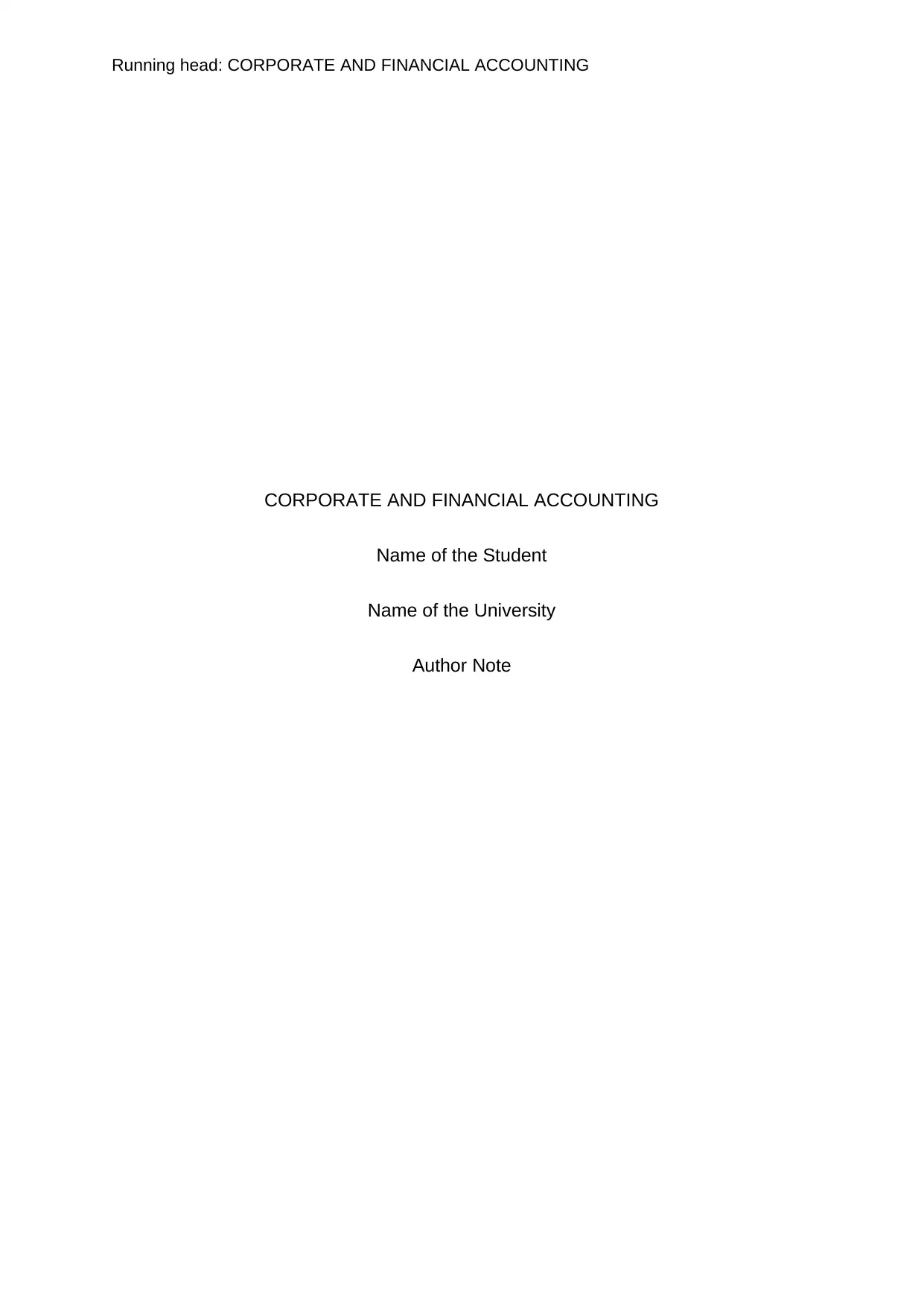
Running head: CORPORATE AND FINANCIAL ACCOUNTING
CORPORATE AND FINANCIAL ACCOUNTING
Name of the Student
Name of the University
Author Note
CORPORATE AND FINANCIAL ACCOUNTING
Name of the Student
Name of the University
Author Note
Paraphrase This Document
Need a fresh take? Get an instant paraphrase of this document with our AI Paraphraser
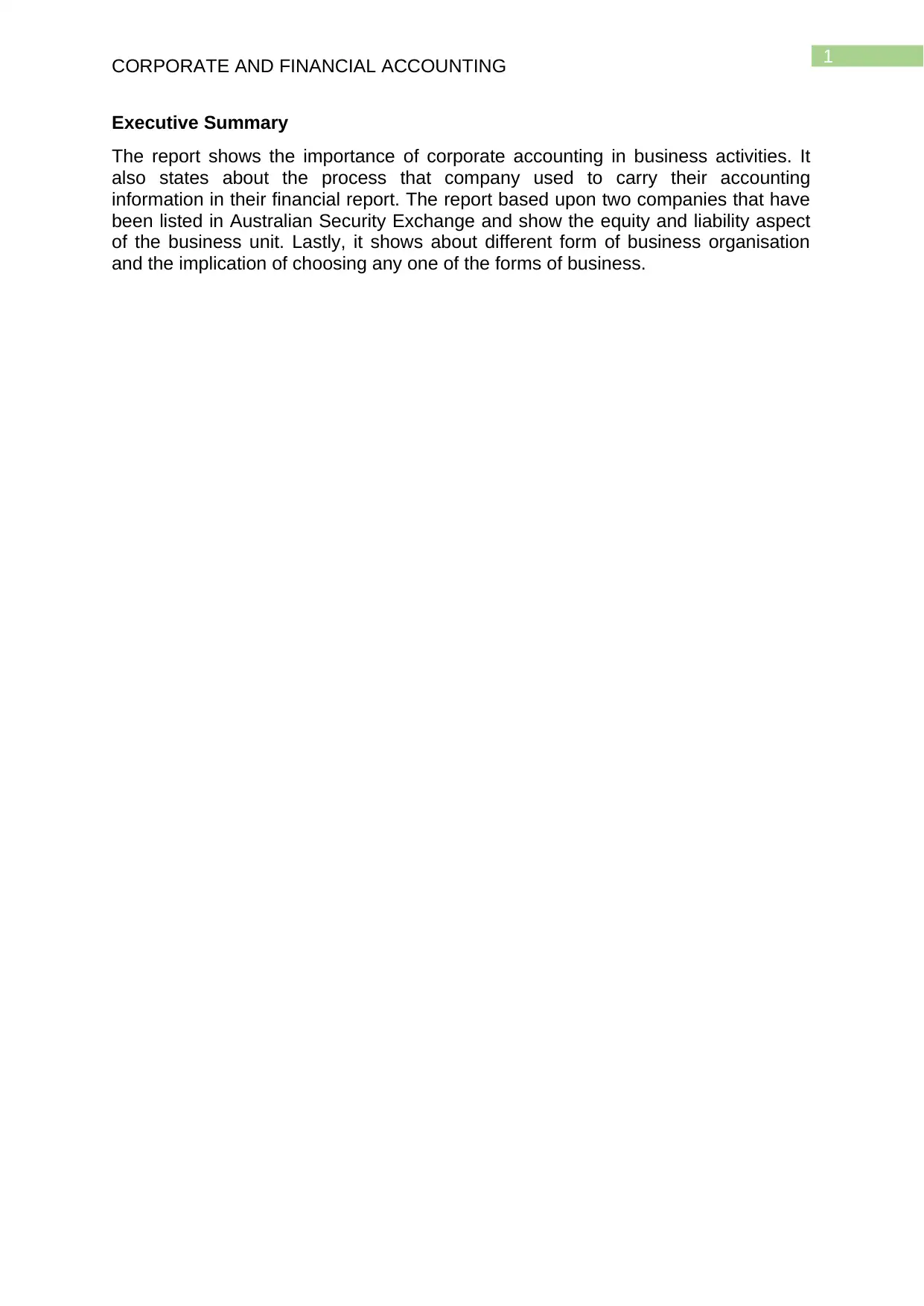
1
CORPORATE AND FINANCIAL ACCOUNTING
Executive Summary
The report shows the importance of corporate accounting in business activities. It
also states about the process that company used to carry their accounting
information in their financial report. The report based upon two companies that have
been listed in Australian Security Exchange and show the equity and liability aspect
of the business unit. Lastly, it shows about different form of business organisation
and the implication of choosing any one of the forms of business.
CORPORATE AND FINANCIAL ACCOUNTING
Executive Summary
The report shows the importance of corporate accounting in business activities. It
also states about the process that company used to carry their accounting
information in their financial report. The report based upon two companies that have
been listed in Australian Security Exchange and show the equity and liability aspect
of the business unit. Lastly, it shows about different form of business organisation
and the implication of choosing any one of the forms of business.
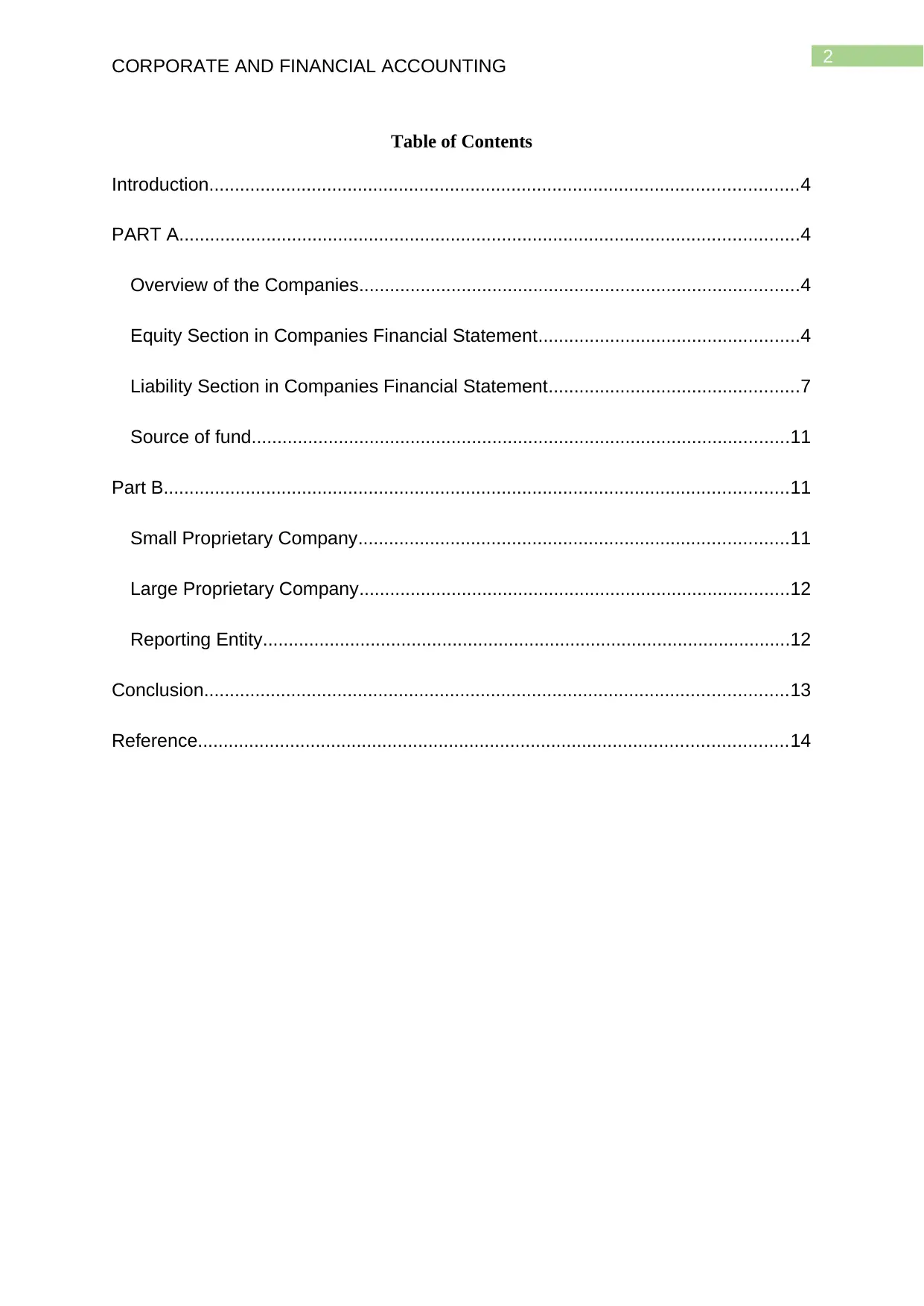
2
CORPORATE AND FINANCIAL ACCOUNTING
Table of Contents
Introduction...................................................................................................................4
PART A.........................................................................................................................4
Overview of the Companies......................................................................................4
Equity Section in Companies Financial Statement...................................................4
Liability Section in Companies Financial Statement.................................................7
Source of fund.........................................................................................................11
Part B..........................................................................................................................11
Small Proprietary Company....................................................................................11
Large Proprietary Company....................................................................................12
Reporting Entity.......................................................................................................12
Conclusion..................................................................................................................13
Reference...................................................................................................................14
CORPORATE AND FINANCIAL ACCOUNTING
Table of Contents
Introduction...................................................................................................................4
PART A.........................................................................................................................4
Overview of the Companies......................................................................................4
Equity Section in Companies Financial Statement...................................................4
Liability Section in Companies Financial Statement.................................................7
Source of fund.........................................................................................................11
Part B..........................................................................................................................11
Small Proprietary Company....................................................................................11
Large Proprietary Company....................................................................................12
Reporting Entity.......................................................................................................12
Conclusion..................................................................................................................13
Reference...................................................................................................................14
⊘ This is a preview!⊘
Do you want full access?
Subscribe today to unlock all pages.

Trusted by 1+ million students worldwide
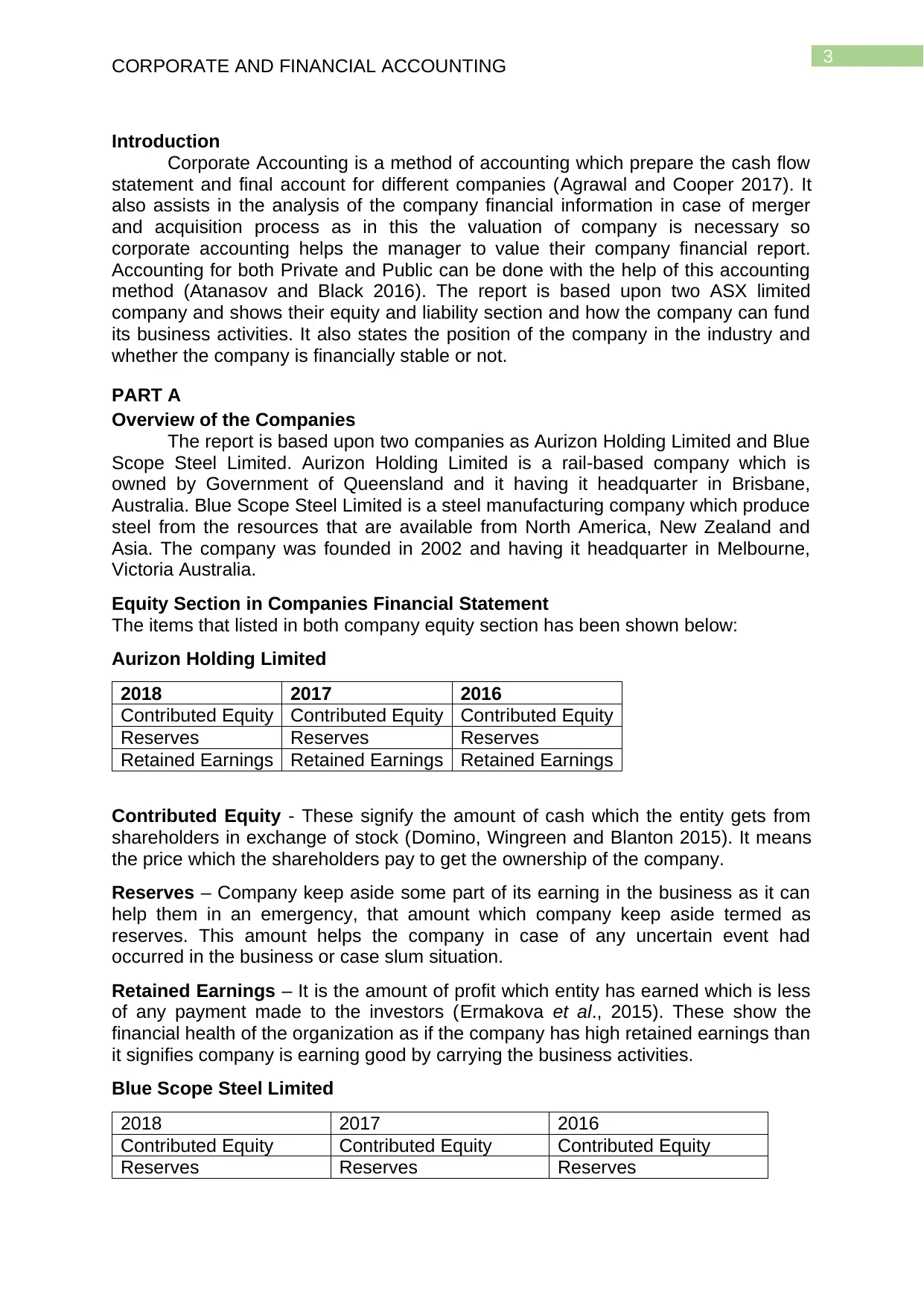
3
CORPORATE AND FINANCIAL ACCOUNTING
Introduction
Corporate Accounting is a method of accounting which prepare the cash flow
statement and final account for different companies (Agrawal and Cooper 2017). It
also assists in the analysis of the company financial information in case of merger
and acquisition process as in this the valuation of company is necessary so
corporate accounting helps the manager to value their company financial report.
Accounting for both Private and Public can be done with the help of this accounting
method (Atanasov and Black 2016). The report is based upon two ASX limited
company and shows their equity and liability section and how the company can fund
its business activities. It also states the position of the company in the industry and
whether the company is financially stable or not.
PART A
Overview of the Companies
The report is based upon two companies as Aurizon Holding Limited and Blue
Scope Steel Limited. Aurizon Holding Limited is a rail-based company which is
owned by Government of Queensland and it having it headquarter in Brisbane,
Australia. Blue Scope Steel Limited is a steel manufacturing company which produce
steel from the resources that are available from North America, New Zealand and
Asia. The company was founded in 2002 and having it headquarter in Melbourne,
Victoria Australia.
Equity Section in Companies Financial Statement
The items that listed in both company equity section has been shown below:
Aurizon Holding Limited
2018 2017 2016
Contributed Equity Contributed Equity Contributed Equity
Reserves Reserves Reserves
Retained Earnings Retained Earnings Retained Earnings
Contributed Equity - These signify the amount of cash which the entity gets from
shareholders in exchange of stock (Domino, Wingreen and Blanton 2015). It means
the price which the shareholders pay to get the ownership of the company.
Reserves – Company keep aside some part of its earning in the business as it can
help them in an emergency, that amount which company keep aside termed as
reserves. This amount helps the company in case of any uncertain event had
occurred in the business or case slum situation.
Retained Earnings – It is the amount of profit which entity has earned which is less
of any payment made to the investors (Ermakova et al., 2015). These show the
financial health of the organization as if the company has high retained earnings than
it signifies company is earning good by carrying the business activities.
Blue Scope Steel Limited
2018 2017 2016
Contributed Equity Contributed Equity Contributed Equity
Reserves Reserves Reserves
CORPORATE AND FINANCIAL ACCOUNTING
Introduction
Corporate Accounting is a method of accounting which prepare the cash flow
statement and final account for different companies (Agrawal and Cooper 2017). It
also assists in the analysis of the company financial information in case of merger
and acquisition process as in this the valuation of company is necessary so
corporate accounting helps the manager to value their company financial report.
Accounting for both Private and Public can be done with the help of this accounting
method (Atanasov and Black 2016). The report is based upon two ASX limited
company and shows their equity and liability section and how the company can fund
its business activities. It also states the position of the company in the industry and
whether the company is financially stable or not.
PART A
Overview of the Companies
The report is based upon two companies as Aurizon Holding Limited and Blue
Scope Steel Limited. Aurizon Holding Limited is a rail-based company which is
owned by Government of Queensland and it having it headquarter in Brisbane,
Australia. Blue Scope Steel Limited is a steel manufacturing company which produce
steel from the resources that are available from North America, New Zealand and
Asia. The company was founded in 2002 and having it headquarter in Melbourne,
Victoria Australia.
Equity Section in Companies Financial Statement
The items that listed in both company equity section has been shown below:
Aurizon Holding Limited
2018 2017 2016
Contributed Equity Contributed Equity Contributed Equity
Reserves Reserves Reserves
Retained Earnings Retained Earnings Retained Earnings
Contributed Equity - These signify the amount of cash which the entity gets from
shareholders in exchange of stock (Domino, Wingreen and Blanton 2015). It means
the price which the shareholders pay to get the ownership of the company.
Reserves – Company keep aside some part of its earning in the business as it can
help them in an emergency, that amount which company keep aside termed as
reserves. This amount helps the company in case of any uncertain event had
occurred in the business or case slum situation.
Retained Earnings – It is the amount of profit which entity has earned which is less
of any payment made to the investors (Ermakova et al., 2015). These show the
financial health of the organization as if the company has high retained earnings than
it signifies company is earning good by carrying the business activities.
Blue Scope Steel Limited
2018 2017 2016
Contributed Equity Contributed Equity Contributed Equity
Reserves Reserves Reserves
Paraphrase This Document
Need a fresh take? Get an instant paraphrase of this document with our AI Paraphraser
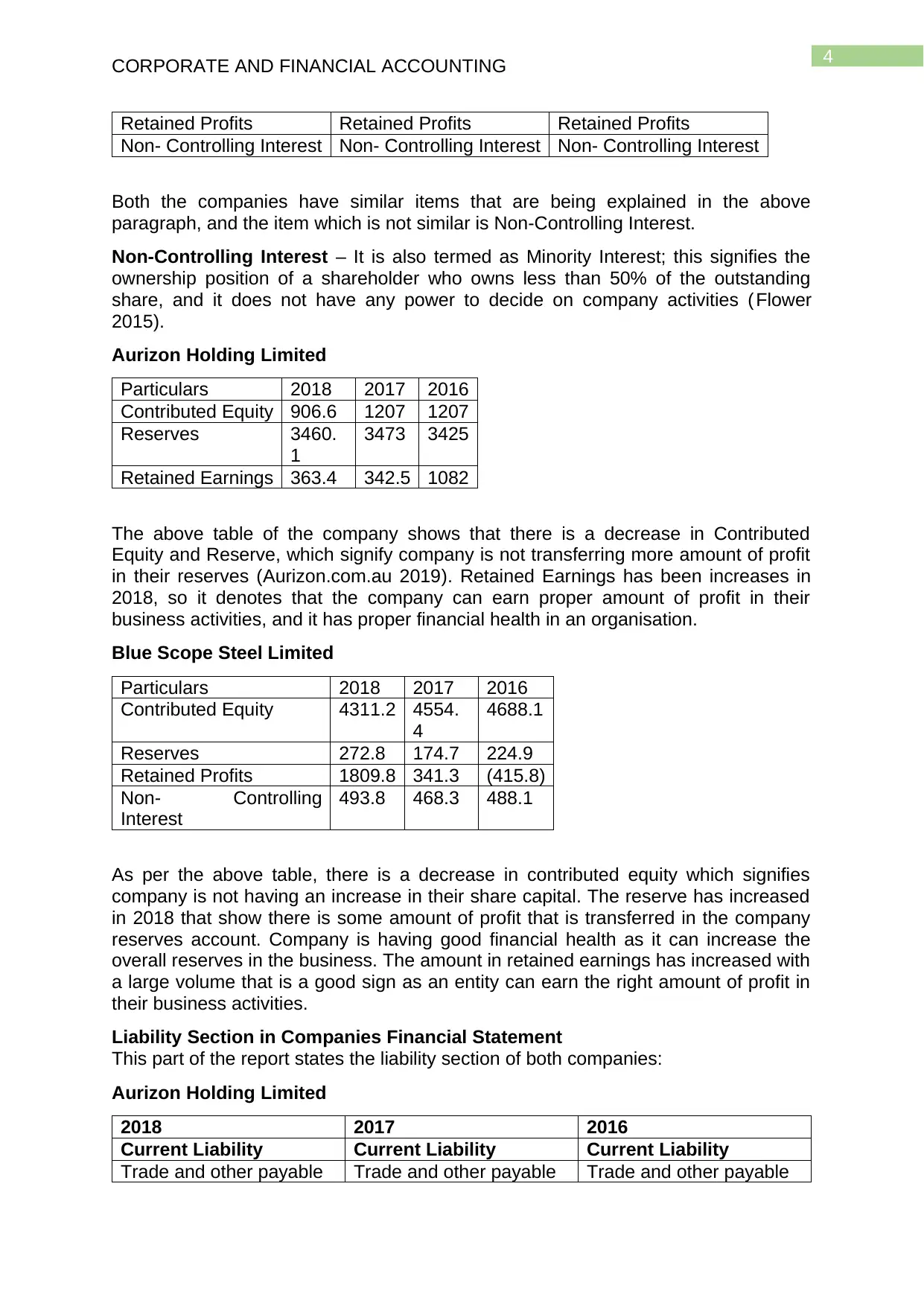
4
CORPORATE AND FINANCIAL ACCOUNTING
Retained Profits Retained Profits Retained Profits
Non- Controlling Interest Non- Controlling Interest Non- Controlling Interest
Both the companies have similar items that are being explained in the above
paragraph, and the item which is not similar is Non-Controlling Interest.
Non-Controlling Interest – It is also termed as Minority Interest; this signifies the
ownership position of a shareholder who owns less than 50% of the outstanding
share, and it does not have any power to decide on company activities ( Flower
2015).
Aurizon Holding Limited
Particulars 2018 2017 2016
Contributed Equity 906.6 1207 1207
Reserves 3460.
1
3473 3425
Retained Earnings 363.4 342.5 1082
The above table of the company shows that there is a decrease in Contributed
Equity and Reserve, which signify company is not transferring more amount of profit
in their reserves (Aurizon.com.au 2019). Retained Earnings has been increases in
2018, so it denotes that the company can earn proper amount of profit in their
business activities, and it has proper financial health in an organisation.
Blue Scope Steel Limited
Particulars 2018 2017 2016
Contributed Equity 4311.2 4554.
4
4688.1
Reserves 272.8 174.7 224.9
Retained Profits 1809.8 341.3 (415.8)
Non- Controlling
Interest
493.8 468.3 488.1
As per the above table, there is a decrease in contributed equity which signifies
company is not having an increase in their share capital. The reserve has increased
in 2018 that show there is some amount of profit that is transferred in the company
reserves account. Company is having good financial health as it can increase the
overall reserves in the business. The amount in retained earnings has increased with
a large volume that is a good sign as an entity can earn the right amount of profit in
their business activities.
Liability Section in Companies Financial Statement
This part of the report states the liability section of both companies:
Aurizon Holding Limited
2018 2017 2016
Current Liability Current Liability Current Liability
Trade and other payable Trade and other payable Trade and other payable
CORPORATE AND FINANCIAL ACCOUNTING
Retained Profits Retained Profits Retained Profits
Non- Controlling Interest Non- Controlling Interest Non- Controlling Interest
Both the companies have similar items that are being explained in the above
paragraph, and the item which is not similar is Non-Controlling Interest.
Non-Controlling Interest – It is also termed as Minority Interest; this signifies the
ownership position of a shareholder who owns less than 50% of the outstanding
share, and it does not have any power to decide on company activities ( Flower
2015).
Aurizon Holding Limited
Particulars 2018 2017 2016
Contributed Equity 906.6 1207 1207
Reserves 3460.
1
3473 3425
Retained Earnings 363.4 342.5 1082
The above table of the company shows that there is a decrease in Contributed
Equity and Reserve, which signify company is not transferring more amount of profit
in their reserves (Aurizon.com.au 2019). Retained Earnings has been increases in
2018, so it denotes that the company can earn proper amount of profit in their
business activities, and it has proper financial health in an organisation.
Blue Scope Steel Limited
Particulars 2018 2017 2016
Contributed Equity 4311.2 4554.
4
4688.1
Reserves 272.8 174.7 224.9
Retained Profits 1809.8 341.3 (415.8)
Non- Controlling
Interest
493.8 468.3 488.1
As per the above table, there is a decrease in contributed equity which signifies
company is not having an increase in their share capital. The reserve has increased
in 2018 that show there is some amount of profit that is transferred in the company
reserves account. Company is having good financial health as it can increase the
overall reserves in the business. The amount in retained earnings has increased with
a large volume that is a good sign as an entity can earn the right amount of profit in
their business activities.
Liability Section in Companies Financial Statement
This part of the report states the liability section of both companies:
Aurizon Holding Limited
2018 2017 2016
Current Liability Current Liability Current Liability
Trade and other payable Trade and other payable Trade and other payable
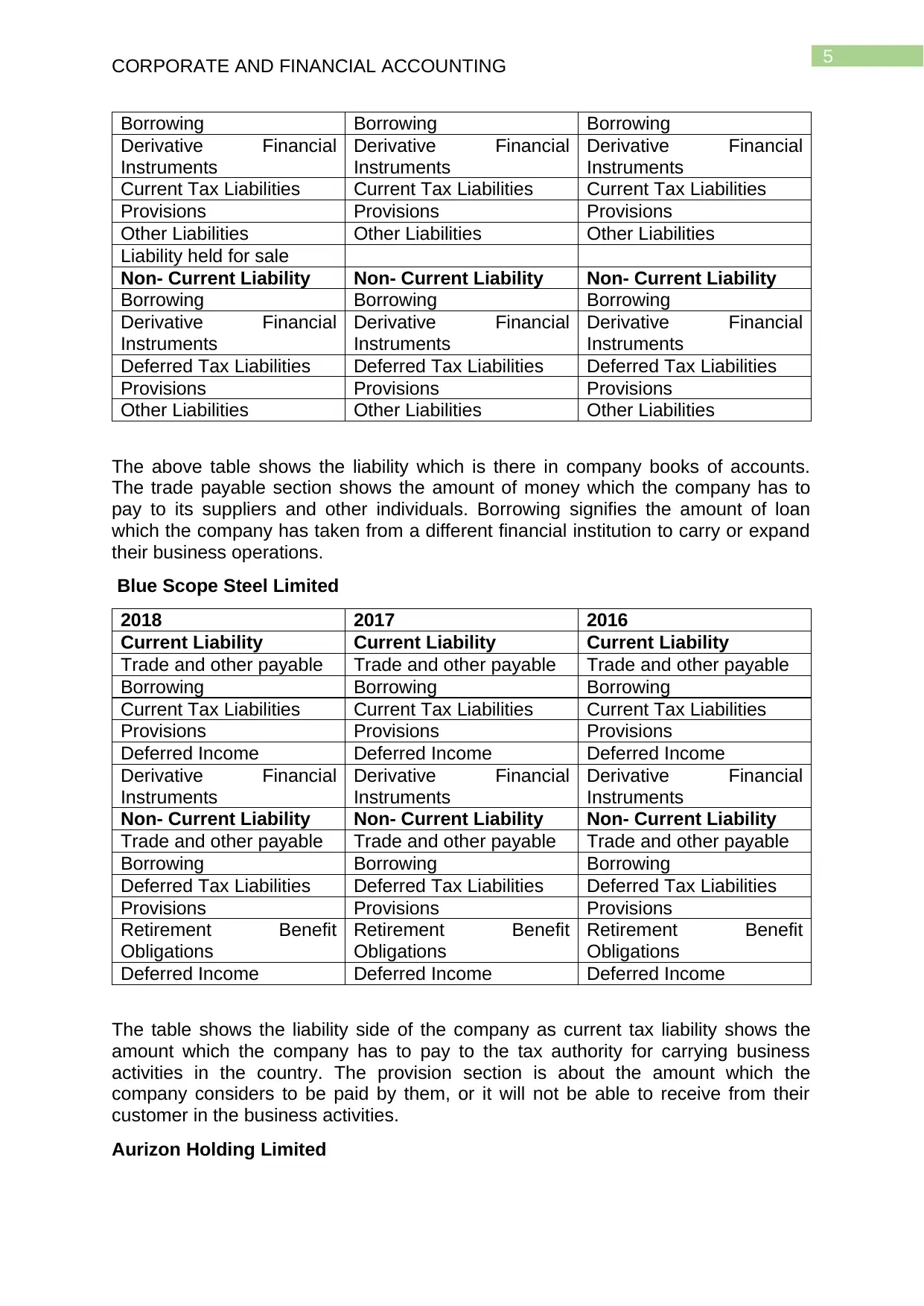
5
CORPORATE AND FINANCIAL ACCOUNTING
Borrowing Borrowing Borrowing
Derivative Financial
Instruments
Derivative Financial
Instruments
Derivative Financial
Instruments
Current Tax Liabilities Current Tax Liabilities Current Tax Liabilities
Provisions Provisions Provisions
Other Liabilities Other Liabilities Other Liabilities
Liability held for sale
Non- Current Liability Non- Current Liability Non- Current Liability
Borrowing Borrowing Borrowing
Derivative Financial
Instruments
Derivative Financial
Instruments
Derivative Financial
Instruments
Deferred Tax Liabilities Deferred Tax Liabilities Deferred Tax Liabilities
Provisions Provisions Provisions
Other Liabilities Other Liabilities Other Liabilities
The above table shows the liability which is there in company books of accounts.
The trade payable section shows the amount of money which the company has to
pay to its suppliers and other individuals. Borrowing signifies the amount of loan
which the company has taken from a different financial institution to carry or expand
their business operations.
Blue Scope Steel Limited
2018 2017 2016
Current Liability Current Liability Current Liability
Trade and other payable Trade and other payable Trade and other payable
Borrowing Borrowing Borrowing
Current Tax Liabilities Current Tax Liabilities Current Tax Liabilities
Provisions Provisions Provisions
Deferred Income Deferred Income Deferred Income
Derivative Financial
Instruments
Derivative Financial
Instruments
Derivative Financial
Instruments
Non- Current Liability Non- Current Liability Non- Current Liability
Trade and other payable Trade and other payable Trade and other payable
Borrowing Borrowing Borrowing
Deferred Tax Liabilities Deferred Tax Liabilities Deferred Tax Liabilities
Provisions Provisions Provisions
Retirement Benefit
Obligations
Retirement Benefit
Obligations
Retirement Benefit
Obligations
Deferred Income Deferred Income Deferred Income
The table shows the liability side of the company as current tax liability shows the
amount which the company has to pay to the tax authority for carrying business
activities in the country. The provision section is about the amount which the
company considers to be paid by them, or it will not be able to receive from their
customer in the business activities.
Aurizon Holding Limited
CORPORATE AND FINANCIAL ACCOUNTING
Borrowing Borrowing Borrowing
Derivative Financial
Instruments
Derivative Financial
Instruments
Derivative Financial
Instruments
Current Tax Liabilities Current Tax Liabilities Current Tax Liabilities
Provisions Provisions Provisions
Other Liabilities Other Liabilities Other Liabilities
Liability held for sale
Non- Current Liability Non- Current Liability Non- Current Liability
Borrowing Borrowing Borrowing
Derivative Financial
Instruments
Derivative Financial
Instruments
Derivative Financial
Instruments
Deferred Tax Liabilities Deferred Tax Liabilities Deferred Tax Liabilities
Provisions Provisions Provisions
Other Liabilities Other Liabilities Other Liabilities
The above table shows the liability which is there in company books of accounts.
The trade payable section shows the amount of money which the company has to
pay to its suppliers and other individuals. Borrowing signifies the amount of loan
which the company has taken from a different financial institution to carry or expand
their business operations.
Blue Scope Steel Limited
2018 2017 2016
Current Liability Current Liability Current Liability
Trade and other payable Trade and other payable Trade and other payable
Borrowing Borrowing Borrowing
Current Tax Liabilities Current Tax Liabilities Current Tax Liabilities
Provisions Provisions Provisions
Deferred Income Deferred Income Deferred Income
Derivative Financial
Instruments
Derivative Financial
Instruments
Derivative Financial
Instruments
Non- Current Liability Non- Current Liability Non- Current Liability
Trade and other payable Trade and other payable Trade and other payable
Borrowing Borrowing Borrowing
Deferred Tax Liabilities Deferred Tax Liabilities Deferred Tax Liabilities
Provisions Provisions Provisions
Retirement Benefit
Obligations
Retirement Benefit
Obligations
Retirement Benefit
Obligations
Deferred Income Deferred Income Deferred Income
The table shows the liability side of the company as current tax liability shows the
amount which the company has to pay to the tax authority for carrying business
activities in the country. The provision section is about the amount which the
company considers to be paid by them, or it will not be able to receive from their
customer in the business activities.
Aurizon Holding Limited
⊘ This is a preview!⊘
Do you want full access?
Subscribe today to unlock all pages.

Trusted by 1+ million students worldwide
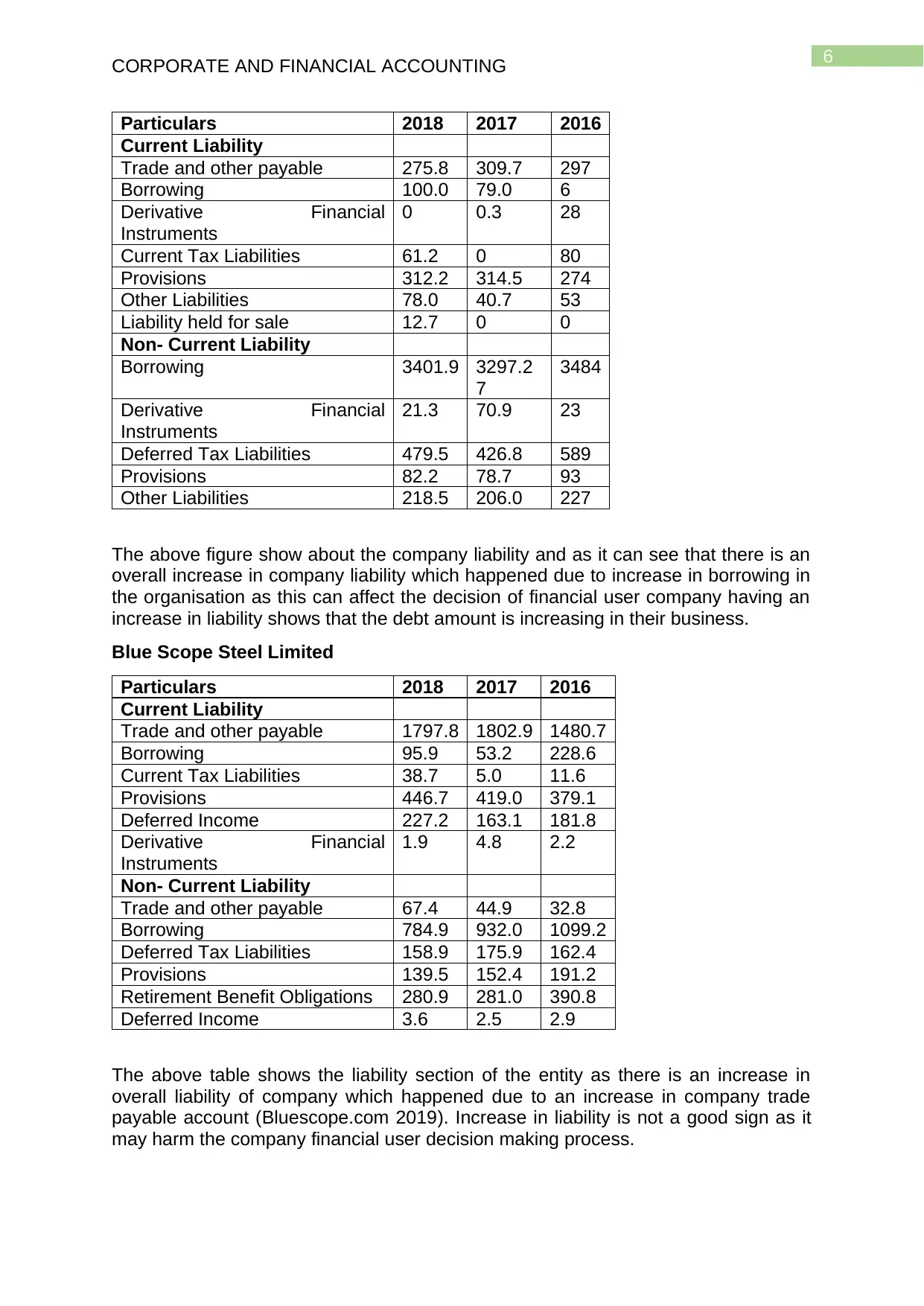
6
CORPORATE AND FINANCIAL ACCOUNTING
Particulars 2018 2017 2016
Current Liability
Trade and other payable 275.8 309.7 297
Borrowing 100.0 79.0 6
Derivative Financial
Instruments
0 0.3 28
Current Tax Liabilities 61.2 0 80
Provisions 312.2 314.5 274
Other Liabilities 78.0 40.7 53
Liability held for sale 12.7 0 0
Non- Current Liability
Borrowing 3401.9 3297.2
7
3484
Derivative Financial
Instruments
21.3 70.9 23
Deferred Tax Liabilities 479.5 426.8 589
Provisions 82.2 78.7 93
Other Liabilities 218.5 206.0 227
The above figure show about the company liability and as it can see that there is an
overall increase in company liability which happened due to increase in borrowing in
the organisation as this can affect the decision of financial user company having an
increase in liability shows that the debt amount is increasing in their business.
Blue Scope Steel Limited
Particulars 2018 2017 2016
Current Liability
Trade and other payable 1797.8 1802.9 1480.7
Borrowing 95.9 53.2 228.6
Current Tax Liabilities 38.7 5.0 11.6
Provisions 446.7 419.0 379.1
Deferred Income 227.2 163.1 181.8
Derivative Financial
Instruments
1.9 4.8 2.2
Non- Current Liability
Trade and other payable 67.4 44.9 32.8
Borrowing 784.9 932.0 1099.2
Deferred Tax Liabilities 158.9 175.9 162.4
Provisions 139.5 152.4 191.2
Retirement Benefit Obligations 280.9 281.0 390.8
Deferred Income 3.6 2.5 2.9
The above table shows the liability section of the entity as there is an increase in
overall liability of company which happened due to an increase in company trade
payable account (Bluescope.com 2019). Increase in liability is not a good sign as it
may harm the company financial user decision making process.
CORPORATE AND FINANCIAL ACCOUNTING
Particulars 2018 2017 2016
Current Liability
Trade and other payable 275.8 309.7 297
Borrowing 100.0 79.0 6
Derivative Financial
Instruments
0 0.3 28
Current Tax Liabilities 61.2 0 80
Provisions 312.2 314.5 274
Other Liabilities 78.0 40.7 53
Liability held for sale 12.7 0 0
Non- Current Liability
Borrowing 3401.9 3297.2
7
3484
Derivative Financial
Instruments
21.3 70.9 23
Deferred Tax Liabilities 479.5 426.8 589
Provisions 82.2 78.7 93
Other Liabilities 218.5 206.0 227
The above figure show about the company liability and as it can see that there is an
overall increase in company liability which happened due to increase in borrowing in
the organisation as this can affect the decision of financial user company having an
increase in liability shows that the debt amount is increasing in their business.
Blue Scope Steel Limited
Particulars 2018 2017 2016
Current Liability
Trade and other payable 1797.8 1802.9 1480.7
Borrowing 95.9 53.2 228.6
Current Tax Liabilities 38.7 5.0 11.6
Provisions 446.7 419.0 379.1
Deferred Income 227.2 163.1 181.8
Derivative Financial
Instruments
1.9 4.8 2.2
Non- Current Liability
Trade and other payable 67.4 44.9 32.8
Borrowing 784.9 932.0 1099.2
Deferred Tax Liabilities 158.9 175.9 162.4
Provisions 139.5 152.4 191.2
Retirement Benefit Obligations 280.9 281.0 390.8
Deferred Income 3.6 2.5 2.9
The above table shows the liability section of the entity as there is an increase in
overall liability of company which happened due to an increase in company trade
payable account (Bluescope.com 2019). Increase in liability is not a good sign as it
may harm the company financial user decision making process.
Paraphrase This Document
Need a fresh take? Get an instant paraphrase of this document with our AI Paraphraser
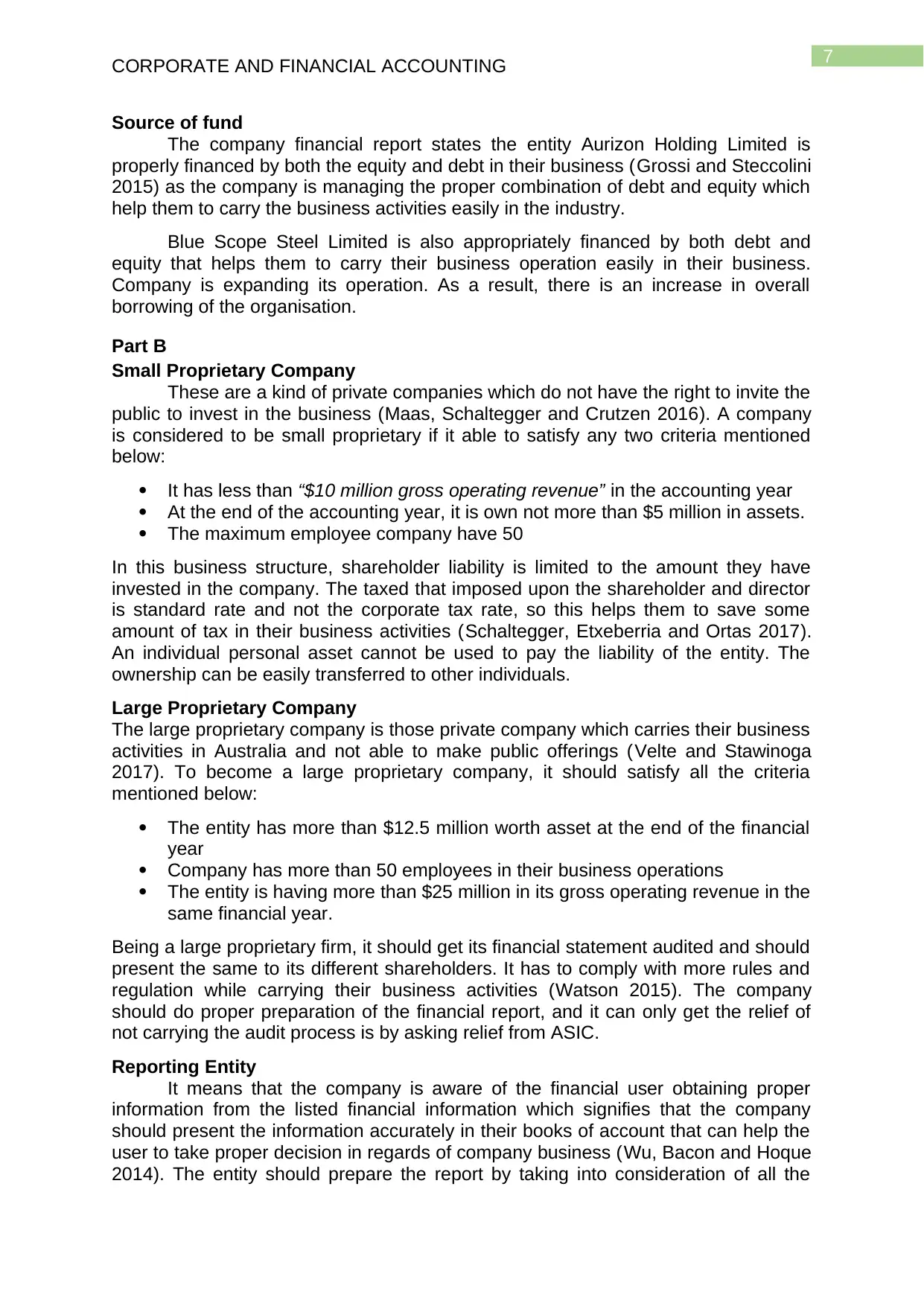
7
CORPORATE AND FINANCIAL ACCOUNTING
Source of fund
The company financial report states the entity Aurizon Holding Limited is
properly financed by both the equity and debt in their business (Grossi and Steccolini
2015) as the company is managing the proper combination of debt and equity which
help them to carry the business activities easily in the industry.
Blue Scope Steel Limited is also appropriately financed by both debt and
equity that helps them to carry their business operation easily in their business.
Company is expanding its operation. As a result, there is an increase in overall
borrowing of the organisation.
Part B
Small Proprietary Company
These are a kind of private companies which do not have the right to invite the
public to invest in the business (Maas, Schaltegger and Crutzen 2016). A company
is considered to be small proprietary if it able to satisfy any two criteria mentioned
below:
It has less than “$10 million gross operating revenue” in the accounting year
At the end of the accounting year, it is own not more than $5 million in assets.
The maximum employee company have 50
In this business structure, shareholder liability is limited to the amount they have
invested in the company. The taxed that imposed upon the shareholder and director
is standard rate and not the corporate tax rate, so this helps them to save some
amount of tax in their business activities (Schaltegger, Etxeberria and Ortas 2017).
An individual personal asset cannot be used to pay the liability of the entity. The
ownership can be easily transferred to other individuals.
Large Proprietary Company
The large proprietary company is those private company which carries their business
activities in Australia and not able to make public offerings (Velte and Stawinoga
2017). To become a large proprietary company, it should satisfy all the criteria
mentioned below:
The entity has more than $12.5 million worth asset at the end of the financial
year
Company has more than 50 employees in their business operations
The entity is having more than $25 million in its gross operating revenue in the
same financial year.
Being a large proprietary firm, it should get its financial statement audited and should
present the same to its different shareholders. It has to comply with more rules and
regulation while carrying their business activities (Watson 2015). The company
should do proper preparation of the financial report, and it can only get the relief of
not carrying the audit process is by asking relief from ASIC.
Reporting Entity
It means that the company is aware of the financial user obtaining proper
information from the listed financial information which signifies that the company
should present the information accurately in their books of account that can help the
user to take proper decision in regards of company business (Wu, Bacon and Hoque
2014). The entity should prepare the report by taking into consideration of all the
CORPORATE AND FINANCIAL ACCOUNTING
Source of fund
The company financial report states the entity Aurizon Holding Limited is
properly financed by both the equity and debt in their business (Grossi and Steccolini
2015) as the company is managing the proper combination of debt and equity which
help them to carry the business activities easily in the industry.
Blue Scope Steel Limited is also appropriately financed by both debt and
equity that helps them to carry their business operation easily in their business.
Company is expanding its operation. As a result, there is an increase in overall
borrowing of the organisation.
Part B
Small Proprietary Company
These are a kind of private companies which do not have the right to invite the
public to invest in the business (Maas, Schaltegger and Crutzen 2016). A company
is considered to be small proprietary if it able to satisfy any two criteria mentioned
below:
It has less than “$10 million gross operating revenue” in the accounting year
At the end of the accounting year, it is own not more than $5 million in assets.
The maximum employee company have 50
In this business structure, shareholder liability is limited to the amount they have
invested in the company. The taxed that imposed upon the shareholder and director
is standard rate and not the corporate tax rate, so this helps them to save some
amount of tax in their business activities (Schaltegger, Etxeberria and Ortas 2017).
An individual personal asset cannot be used to pay the liability of the entity. The
ownership can be easily transferred to other individuals.
Large Proprietary Company
The large proprietary company is those private company which carries their business
activities in Australia and not able to make public offerings (Velte and Stawinoga
2017). To become a large proprietary company, it should satisfy all the criteria
mentioned below:
The entity has more than $12.5 million worth asset at the end of the financial
year
Company has more than 50 employees in their business operations
The entity is having more than $25 million in its gross operating revenue in the
same financial year.
Being a large proprietary firm, it should get its financial statement audited and should
present the same to its different shareholders. It has to comply with more rules and
regulation while carrying their business activities (Watson 2015). The company
should do proper preparation of the financial report, and it can only get the relief of
not carrying the audit process is by asking relief from ASIC.
Reporting Entity
It means that the company is aware of the financial user obtaining proper
information from the listed financial information which signifies that the company
should present the information accurately in their books of account that can help the
user to take proper decision in regards of company business (Wu, Bacon and Hoque
2014). The entity should prepare the report by taking into consideration of all the
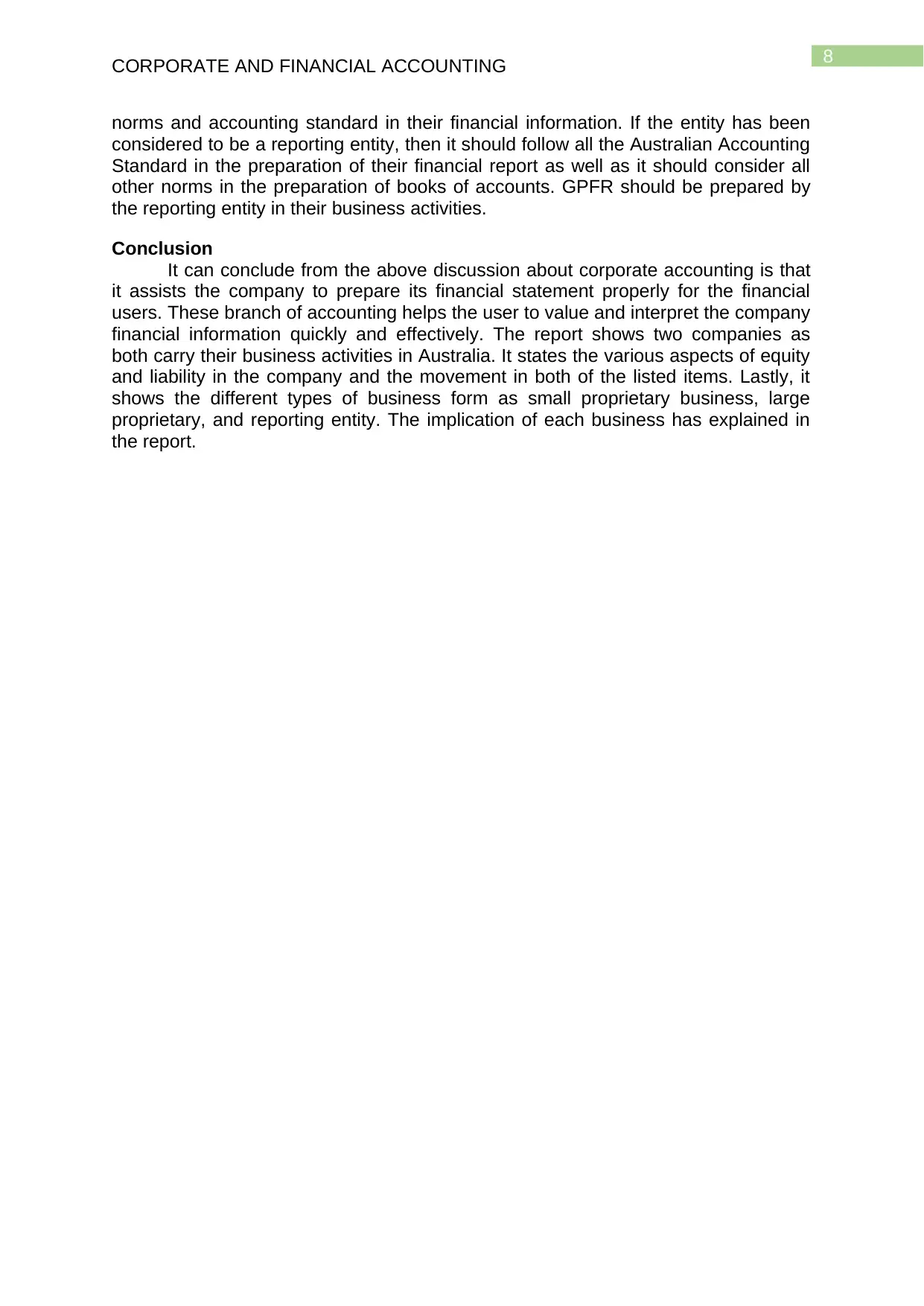
8
CORPORATE AND FINANCIAL ACCOUNTING
norms and accounting standard in their financial information. If the entity has been
considered to be a reporting entity, then it should follow all the Australian Accounting
Standard in the preparation of their financial report as well as it should consider all
other norms in the preparation of books of accounts. GPFR should be prepared by
the reporting entity in their business activities.
Conclusion
It can conclude from the above discussion about corporate accounting is that
it assists the company to prepare its financial statement properly for the financial
users. These branch of accounting helps the user to value and interpret the company
financial information quickly and effectively. The report shows two companies as
both carry their business activities in Australia. It states the various aspects of equity
and liability in the company and the movement in both of the listed items. Lastly, it
shows the different types of business form as small proprietary business, large
proprietary, and reporting entity. The implication of each business has explained in
the report.
CORPORATE AND FINANCIAL ACCOUNTING
norms and accounting standard in their financial information. If the entity has been
considered to be a reporting entity, then it should follow all the Australian Accounting
Standard in the preparation of their financial report as well as it should consider all
other norms in the preparation of books of accounts. GPFR should be prepared by
the reporting entity in their business activities.
Conclusion
It can conclude from the above discussion about corporate accounting is that
it assists the company to prepare its financial statement properly for the financial
users. These branch of accounting helps the user to value and interpret the company
financial information quickly and effectively. The report shows two companies as
both carry their business activities in Australia. It states the various aspects of equity
and liability in the company and the movement in both of the listed items. Lastly, it
shows the different types of business form as small proprietary business, large
proprietary, and reporting entity. The implication of each business has explained in
the report.
⊘ This is a preview!⊘
Do you want full access?
Subscribe today to unlock all pages.

Trusted by 1+ million students worldwide
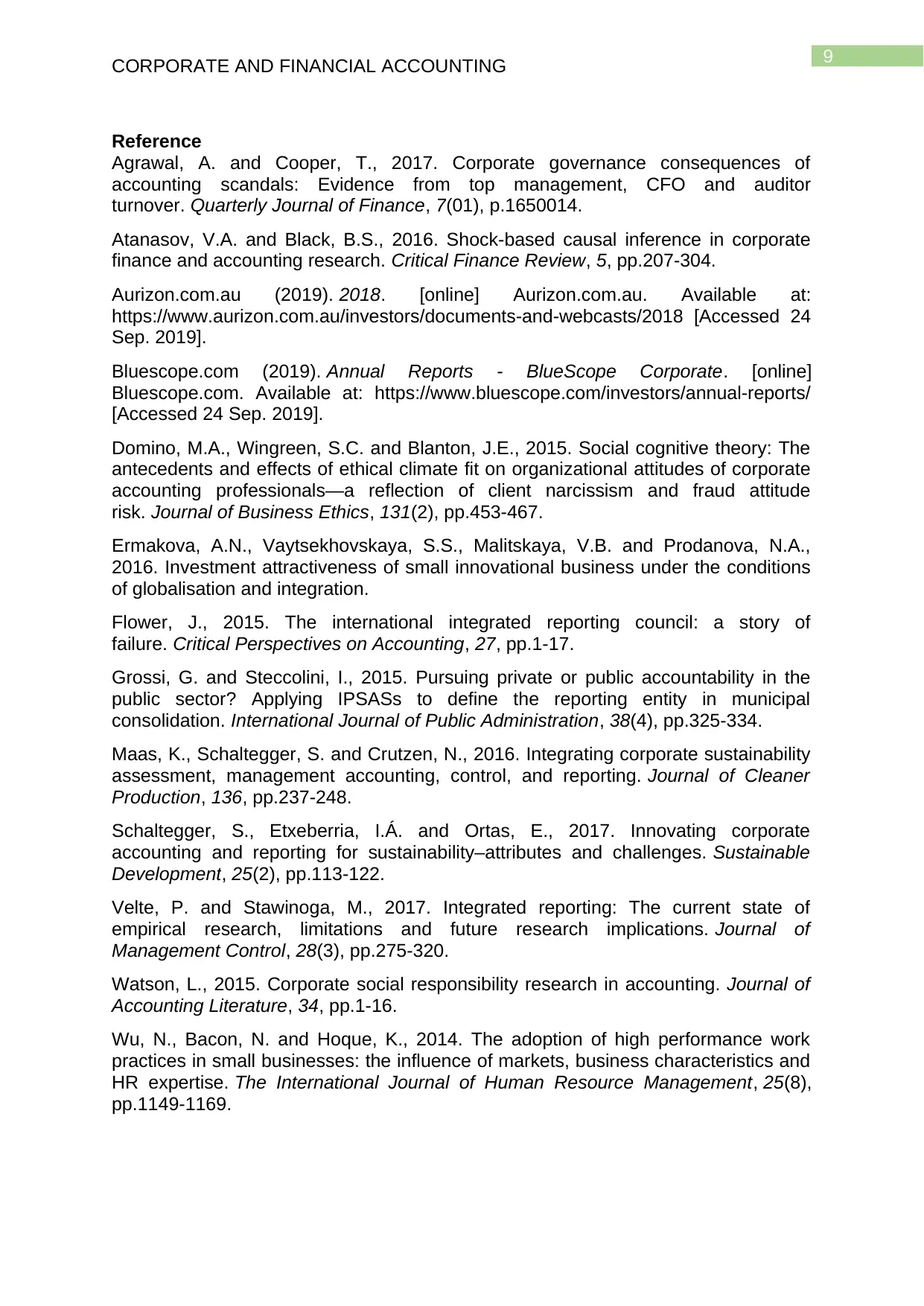
9
CORPORATE AND FINANCIAL ACCOUNTING
Reference
Agrawal, A. and Cooper, T., 2017. Corporate governance consequences of
accounting scandals: Evidence from top management, CFO and auditor
turnover. Quarterly Journal of Finance, 7(01), p.1650014.
Atanasov, V.A. and Black, B.S., 2016. Shock-based causal inference in corporate
finance and accounting research. Critical Finance Review, 5, pp.207-304.
Aurizon.com.au (2019). 2018. [online] Aurizon.com.au. Available at:
https://www.aurizon.com.au/investors/documents-and-webcasts/2018 [Accessed 24
Sep. 2019].
Bluescope.com (2019). Annual Reports - BlueScope Corporate. [online]
Bluescope.com. Available at: https://www.bluescope.com/investors/annual-reports/
[Accessed 24 Sep. 2019].
Domino, M.A., Wingreen, S.C. and Blanton, J.E., 2015. Social cognitive theory: The
antecedents and effects of ethical climate fit on organizational attitudes of corporate
accounting professionals—a reflection of client narcissism and fraud attitude
risk. Journal of Business Ethics, 131(2), pp.453-467.
Ermakova, A.N., Vaytsekhovskaya, S.S., Malitskaya, V.B. and Prodanova, N.А.,
2016. Investment attractiveness of small innovational business under the conditions
of globalisation and integration.
Flower, J., 2015. The international integrated reporting council: a story of
failure. Critical Perspectives on Accounting, 27, pp.1-17.
Grossi, G. and Steccolini, I., 2015. Pursuing private or public accountability in the
public sector? Applying IPSASs to define the reporting entity in municipal
consolidation. International Journal of Public Administration, 38(4), pp.325-334.
Maas, K., Schaltegger, S. and Crutzen, N., 2016. Integrating corporate sustainability
assessment, management accounting, control, and reporting. Journal of Cleaner
Production, 136, pp.237-248.
Schaltegger, S., Etxeberria, I.Á. and Ortas, E., 2017. Innovating corporate
accounting and reporting for sustainability–attributes and challenges. Sustainable
Development, 25(2), pp.113-122.
Velte, P. and Stawinoga, M., 2017. Integrated reporting: The current state of
empirical research, limitations and future research implications. Journal of
Management Control, 28(3), pp.275-320.
Watson, L., 2015. Corporate social responsibility research in accounting. Journal of
Accounting Literature, 34, pp.1-16.
Wu, N., Bacon, N. and Hoque, K., 2014. The adoption of high performance work
practices in small businesses: the influence of markets, business characteristics and
HR expertise. The International Journal of Human Resource Management, 25(8),
pp.1149-1169.
CORPORATE AND FINANCIAL ACCOUNTING
Reference
Agrawal, A. and Cooper, T., 2017. Corporate governance consequences of
accounting scandals: Evidence from top management, CFO and auditor
turnover. Quarterly Journal of Finance, 7(01), p.1650014.
Atanasov, V.A. and Black, B.S., 2016. Shock-based causal inference in corporate
finance and accounting research. Critical Finance Review, 5, pp.207-304.
Aurizon.com.au (2019). 2018. [online] Aurizon.com.au. Available at:
https://www.aurizon.com.au/investors/documents-and-webcasts/2018 [Accessed 24
Sep. 2019].
Bluescope.com (2019). Annual Reports - BlueScope Corporate. [online]
Bluescope.com. Available at: https://www.bluescope.com/investors/annual-reports/
[Accessed 24 Sep. 2019].
Domino, M.A., Wingreen, S.C. and Blanton, J.E., 2015. Social cognitive theory: The
antecedents and effects of ethical climate fit on organizational attitudes of corporate
accounting professionals—a reflection of client narcissism and fraud attitude
risk. Journal of Business Ethics, 131(2), pp.453-467.
Ermakova, A.N., Vaytsekhovskaya, S.S., Malitskaya, V.B. and Prodanova, N.А.,
2016. Investment attractiveness of small innovational business under the conditions
of globalisation and integration.
Flower, J., 2015. The international integrated reporting council: a story of
failure. Critical Perspectives on Accounting, 27, pp.1-17.
Grossi, G. and Steccolini, I., 2015. Pursuing private or public accountability in the
public sector? Applying IPSASs to define the reporting entity in municipal
consolidation. International Journal of Public Administration, 38(4), pp.325-334.
Maas, K., Schaltegger, S. and Crutzen, N., 2016. Integrating corporate sustainability
assessment, management accounting, control, and reporting. Journal of Cleaner
Production, 136, pp.237-248.
Schaltegger, S., Etxeberria, I.Á. and Ortas, E., 2017. Innovating corporate
accounting and reporting for sustainability–attributes and challenges. Sustainable
Development, 25(2), pp.113-122.
Velte, P. and Stawinoga, M., 2017. Integrated reporting: The current state of
empirical research, limitations and future research implications. Journal of
Management Control, 28(3), pp.275-320.
Watson, L., 2015. Corporate social responsibility research in accounting. Journal of
Accounting Literature, 34, pp.1-16.
Wu, N., Bacon, N. and Hoque, K., 2014. The adoption of high performance work
practices in small businesses: the influence of markets, business characteristics and
HR expertise. The International Journal of Human Resource Management, 25(8),
pp.1149-1169.
1 out of 10
Related Documents
Your All-in-One AI-Powered Toolkit for Academic Success.
+13062052269
info@desklib.com
Available 24*7 on WhatsApp / Email
![[object Object]](/_next/static/media/star-bottom.7253800d.svg)
Unlock your academic potential
Copyright © 2020–2025 A2Z Services. All Rights Reserved. Developed and managed by ZUCOL.





